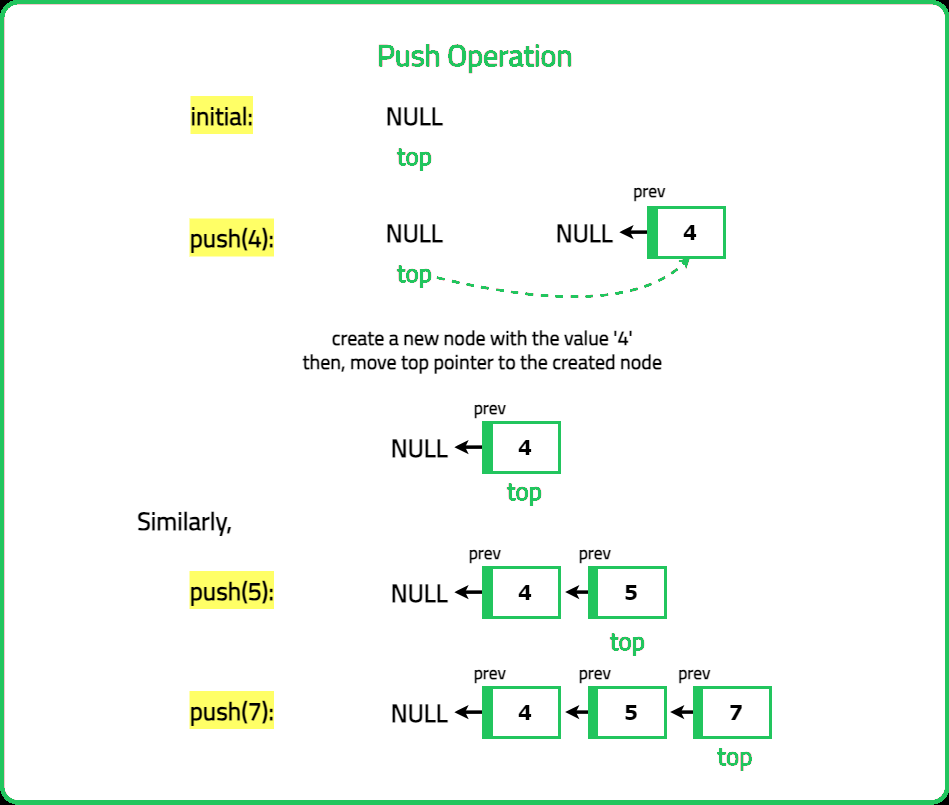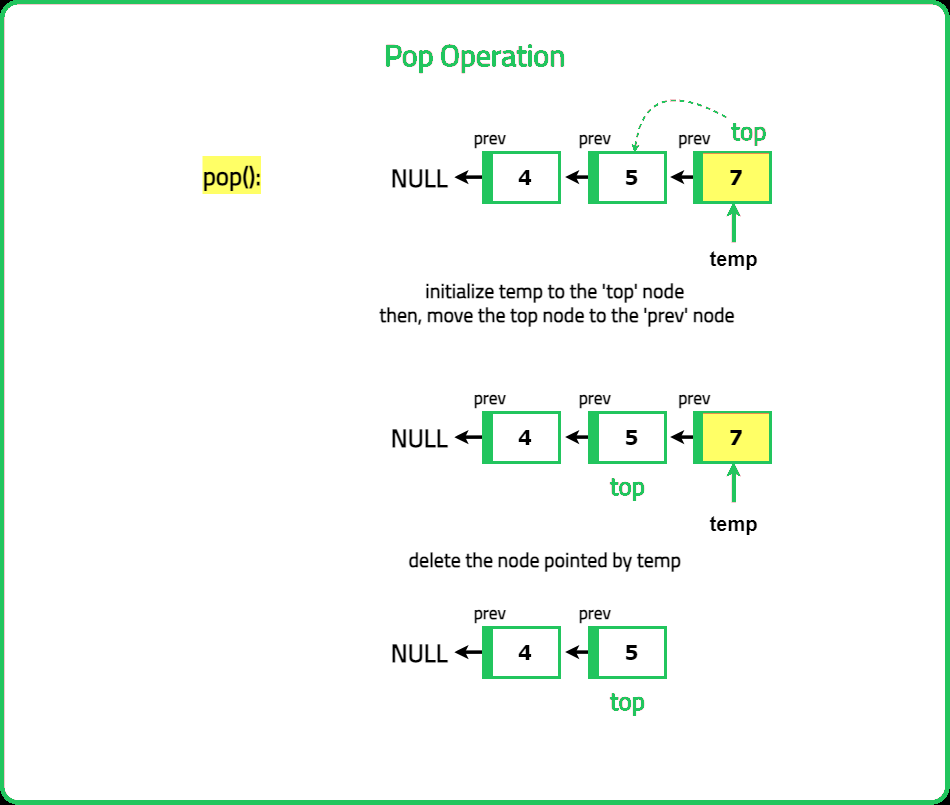12345678910111213141516171819202122232425262728293031323334353637383940414243444546474849505152535455565758596061626364656667686970717273747576777879808182838485868788899091929394959697
#include <bits/stdc++.h>
using namespace std;
// Node structure
struct Node {
int val;
Node *next;
Node(int d) {
val = d;
next = NULL;
}
};
// Structure to represent stack
class LinkedListStack {
private:
Node *head; // Top of Stack
int size; // Size
public:
// Constructor
LinkedListStack() {
head = NULL;
size = 0;
}
// Method to push an element onto the stack
void push(int x) {
// Creating a node
Node *element = new Node(x);
element->next = head; // Updating the pointers
head = element; // Updating the top
// Increment size by 1
size++;
}
// Method to pop an element from the stack
int pop() {
// If the stack is empty
if (head == NULL) {
return -1; // Pop operation cannot be performed
}
int value = head->val; // Get the top value
Node *temp = head; // Store the top temporarily
head = head->next; // Update top to next node
delete temp; // Delete old top node
size--; // Decrement size
return value; // Return data
}
// Method to get the top element of the stack
int top() {
// If the stack is empty
if (head == NULL) {
return -1; // Top element cannot be accessed
}
return head->val; // Return the top
}
// Method to check if the stack is empty
bool isEmpty() {
return (size == 0);
}
};
int main() {
// Creating a stack
LinkedListStack st;
// List of commands
vector<string> commands = {"LinkedListStack", "push", "push",
"pop", "top", "isEmpty"};
// List of inputs
vector<vector<int>> inputs = {{}, {3}, {7}, {}, {}, {}};
for (int i = 0; i < commands.size(); ++i) {
if (commands[i] == "push") {
st.push(inputs[i][0]);
cout << "null ";
} else if (commands[i] == "pop") {
cout << st.pop() << " ";
} else if (commands[i] == "top") {
cout << st.top() << " ";
} else if (commands[i] == "isEmpty") {
cout << (st.isEmpty() ? "true" : "false") << " ";
} else if (commands[i] == "LinkedListStack") {
cout << "null ";
}
}
return 0;
}
12345678910111213141516171819202122232425262728293031323334353637383940414243444546474849505152535455565758596061626364656667686970717273747576777879808182838485868788899091929394
import java.util.*;
// Node structure
class Node {
int val;
Node next;
Node(int d) {
val = d;
next = null;
}
}
// Structure to represent stack
class LinkedListStack {
private Node head; // Top of Stack
private int size; // Size
// Constructor
public LinkedListStack() {
head = null;
size = 0;
}
// Method to push an element onto the stack
public void push(int x) {
// Creating a node
Node element = new Node(x);
element.next = head; // Updating the pointers
head = element; // Updating the top
// Increment size by 1
size++;
}
// Method to pop an element from the stack
public int pop() {
// If the stack is empty
if (head == null) {
return -1; // Pop operation cannot be performed
}
int value = head.val; // Get the top value
Node temp = head; // Store the top temporarily
head = head.next; // Update top to next node
temp = null; // Delete old top node
size--; // Decrement size
return value; // Return data
}
// Method to get the top element of the stack
public int top() {
// If the stack is empty
if (head == null) {
return -1; // Top element cannot be accessed
}
return head.val; // Return the top
}
// Method to check if the stack is empty
public boolean isEmpty() {
return (size == 0);
}
}
class Main{
public static void main(String[] args) {
// Creating a stack
LinkedListStack st = new LinkedListStack();
// Array of commands
String[] commands = {"LinkedListStack", "push", "push",
"pop", "top", "isEmpty"};
// Array of inputs
int[][] inputs = {{}, {3}, {7}, {}, {}, {}};
for (int i = 0; i < commands.length; ++i) {
if (commands[i].equals("push")) {
st.push(inputs[i][0]);
System.out.print("null ");
} else if (commands[i].equals("pop")) {
System.out.print(st.pop() + " ");
} else if (commands[i].equals("top")) {
System.out.print(st.top() + " ");
} else if (commands[i].equals("isEmpty")) {
System.out.print((st.isEmpty() ? "true" : "false") + " ");
} else if (commands[i].equals("LinkedListStack")) {
System.out.print("null ");
}
}
}
}
123456789101112131415161718192021222324252627282930313233343536373839404142434445464748495051525354555657585960616263646566676869
# Node structure
class Node:
def __init__(self, d):
self.val = d
self.next = None
# Structure to represent stack
class LinkedListStack:
def __init__(self):
self.head = None # Top of Stack
self.size = 0 # Size
# Method to push an element onto the stack
def push(self, x):
# Creating a node
element = Node(x)
element.next = self.head # Updating the pointers
self.head = element # Updating the top
# Increment size by 1
self.size += 1
# Method to pop an element from the stack
def pop(self):
# If the stack is empty
if self.head is None:
return -1 # Pop operation cannot be performed
value = self.head.val # Get the top value
temp = self.head # Store the top temporarily
self.head = self.head.next # Update top to next node
del temp # Delete old top node
self.size -= 1 # Decrement size
return value # Return data
# Method to get the top element of the stack
def top(self):
# If the stack is empty
if self.head is None:
return -1 # Top element cannot be accessed
return self.head.val # Return the top
# Method to check if the stack is empty
def isEmpty(self):
return self.size == 0
# Creating a stack
st = LinkedListStack()
# List of commands
commands = ["LinkedListStack", "push", "push", "pop", "top", "isEmpty"]
# List of inputs
inputs = [[], [3], [7], [], [], []]
for i in range(len(commands)):
if commands[i] == "push":
st.push(inputs[i][0])
print("null", end=" ")
elif commands[i] == "pop":
print(st.pop(), end=" ")
elif commands[i] == "top":
print(st.top(), end=" ")
elif commands[i] == "isEmpty":
print("true" if st.is_empty() else "false", end=" ")
elif commands[i] == "LinkedListStack":
print("null", end=" ")
123456789101112131415161718192021222324252627282930313233343536373839404142434445464748495051525354555657585960616263646566676869707172737475767778798081
class Node {
constructor(d) {
this.val = d;
this.next = null;
}
}
class LinkedListStack {
constructor() {
this.head = null;
this.size = 0;
}
push(x) {
const element = new Node(x);
element.next = this.head;
this.head = element;
this.size++;
}
pop() {
if (this.head === null) {
return -1;
}
const value = this.head.val;
const temp = this.head;
this.head = this.head.next;
this.size--;
return value;
}
top() {
if (this.head === null) {
return -1;
}
return this.head.val;
}
isEmpty() {
return (this.size === 0);
}
}
const st = new LinkedListStack();
const commands = ["LinkedListStack", "push", "push",
"pop", "top", "isEmpty"];
const inputs = [[], [3], [7], [], [], []];
for (let i = 0; i < commands.length; ++i) {
if (commands[i] === "push") {
st.push(inputs[i][0]);
console.log("null");
} else if (commands[i] === "pop") {
console.log(st.pop());
} else if (commands[i] === "top") {
console.log(st.top());
} else if (commands[i] === "isEmpty") {
console.log(st.isEmpty() ? "true" : "false");
} else if (commands[i] === "LinkedListStack") {
console.log("null");
}
}

